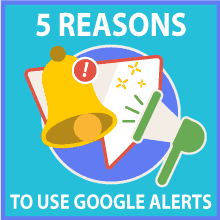
Google Alerts is one of the best tools you can use to keep track of key activities and news online.
Every sales team should be monitoring up-to-date information on their key accounts. This allows building deeper relationships with clients, quickly reacting to changes in the market and taking advantage of new opportunities with prospects.
It’s also free and easy to use — this alone can be the reason you make it a part of your toolset. But it’s also pretty smart, and with some tweaking, Google Alerts can significantly enhance your sales process.
In this article, we explain some key ways to incorporate Google Alerts into your strategy, along with a few thoughts on how it holds up in the long run.
What is Google Alerts and how does it work?
In case you haven’t worked with Google Alerts before, here’s a quick definition to get you started.
Basically, Google has built Alerts to be a lightweight tool for keywords tracking. Alerts will send you a notification each time new content containing the keywords you set up gets published.
The design of Alerts is barebones which makes getting started easy:
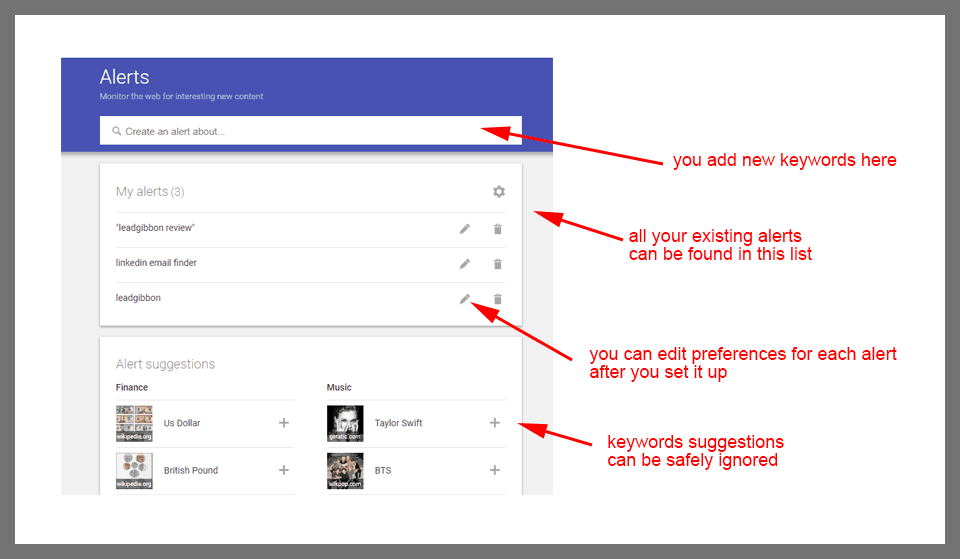
The simplistic design does have a couple of tricks up its sleeve though.
Most importantly, when you add your first keyword to Google Alerts you’ll notice some important options for you to play with.
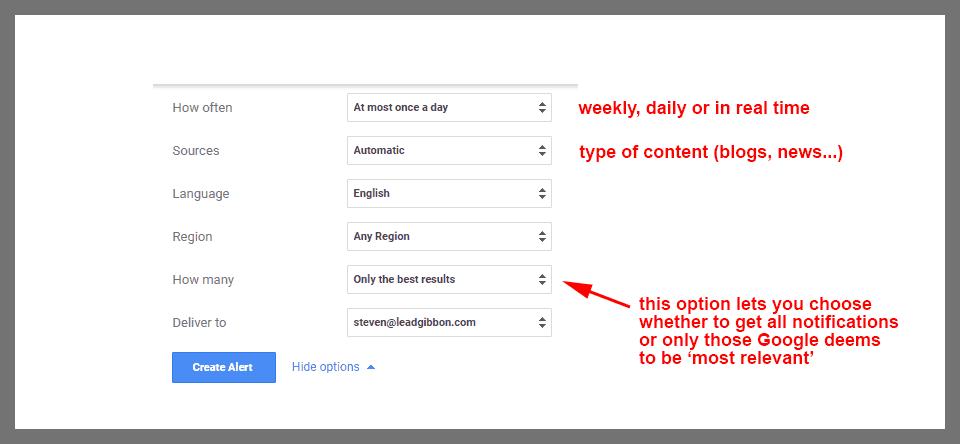
These make it easy to achieve more granular and tailored results. You can choose the type of content (news, blogs, etc) you want to monitor, its language and region, the frequency of updates Google Alerts will send you and whether to receive alerts about all new articles or only the most popular.
For example, If you’re setting up an alert for a generic keyword that comes up a lot (like ‘cybersecurity’), you’ll probably want to set up your Google Alerts like this:
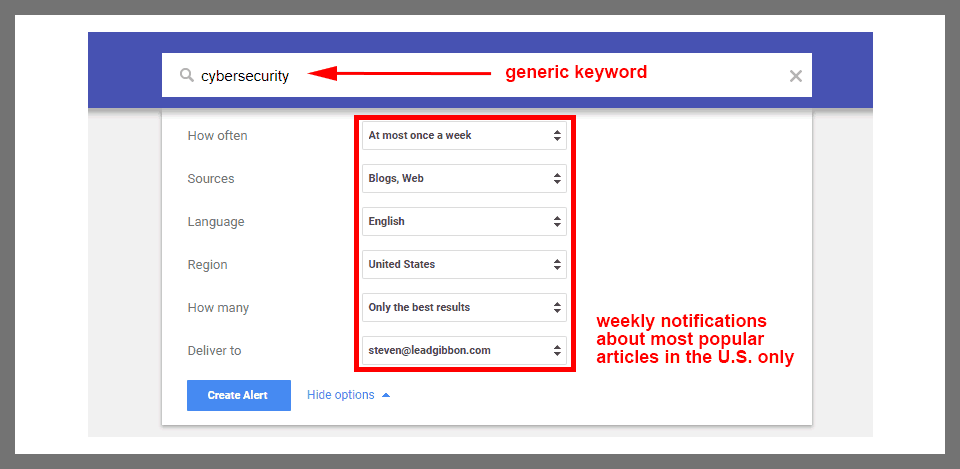
And if you plan on monitoring more specific keywords (like new reviews for your product), choose something similar to this:
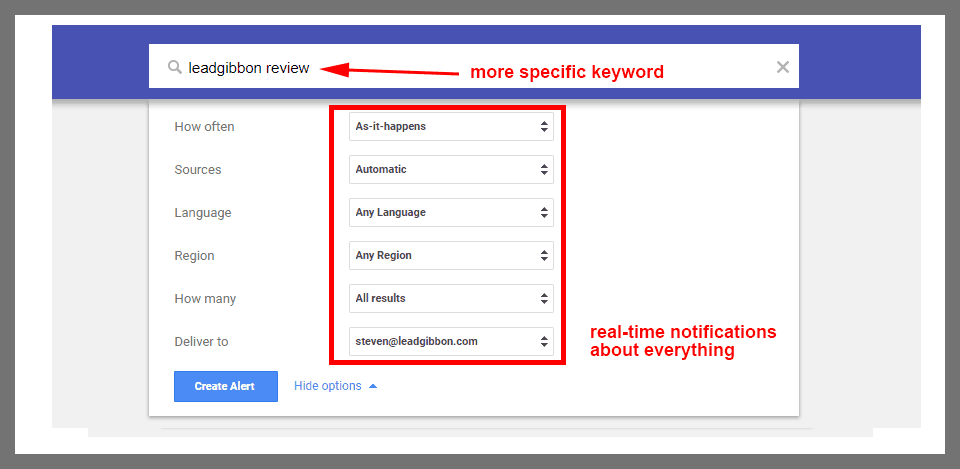
Also, note that Google Alerts supports Boolean operators, which allows you to be much more granular when setting up your keywords.
For example, if you want to get alerts for a specific keyword only, use quotation marks (“ ”) to tell Google that it should ignore other combinations of the same words. Google Alerts shows a preview of your future notifications, so you can see if you’ve set it up correctly:
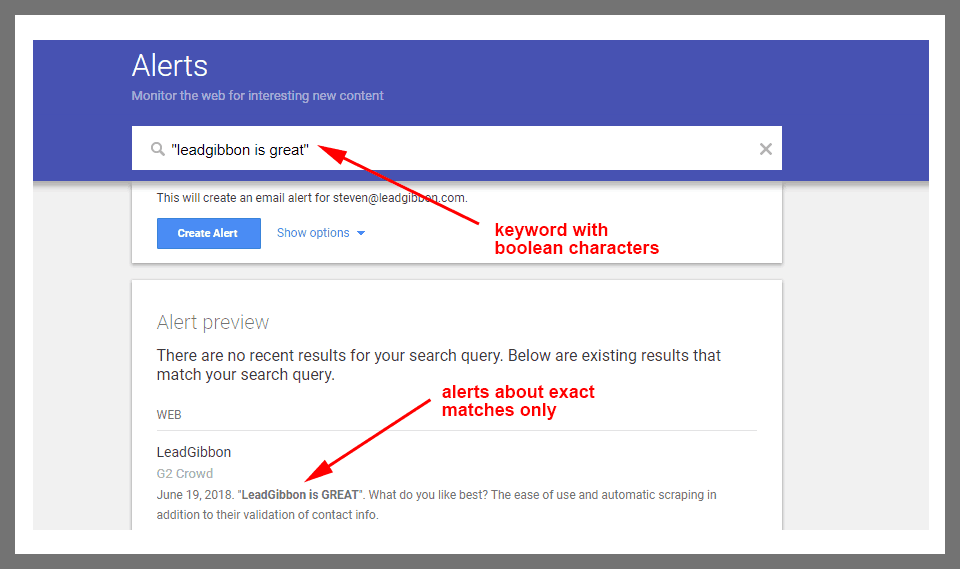
You can use Boolean operators in a variety of ways to make Google Alerts a more sales-oriented tool, and we’ll talk about some of them below. In the meantime, you can see the whole list of supported Boolean characters here.
That’s it. After a quick set up, Google Alerts will start sending out notifications to the email address you specified.
So how can Google Alerts improve your sales workflow?
Find new customers
One of the best ways to take advantage of Google Alerts for sales is setting up notifications for possible sales opportunities.
For example, let’s say that your business is located in Pittsburgh and you’re looking for possible partnerships with new companies in the area. Set up an alert for something like ‘new pittsburgh based startup’ and you’re instantly tracking local news:
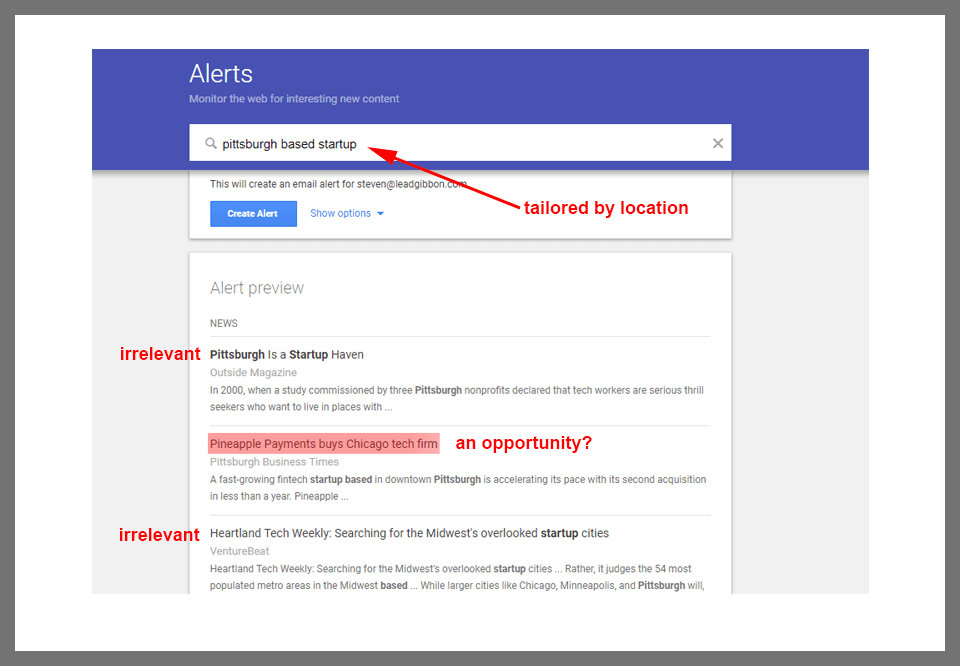
Obviously, you can look at local news websites… but why would you? Using Google Alerts is all about saving time. Instead of performing searches you can keep track of all relevant notifications right from your inbox.
Here’s another example. Let’s say that your company offers various marketing services. How do you find new leads?
In Google Alerts, you can simply set up a keyword for something like “looking for a marketing manager” and it will send you notifications each time a company posts a new vacancy. Chances are that if they are looking for a new hire, they will be more than eager to hear your offer, too.
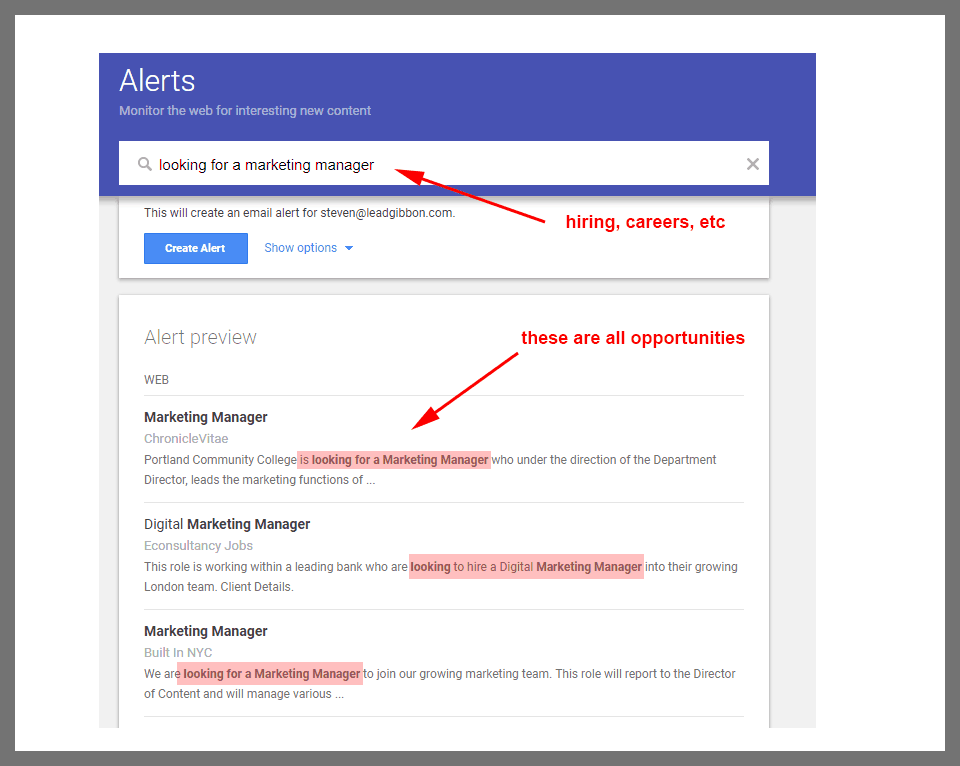
The best thing about it is its timeliness. The alerts will be delivered to your email soon after new content is published. You can stay on top of your game and really take advantage of new opportunities.
Optimize your timing
Sometimes you want to pitch your product to a specific client, but you know that the opportunity isn’t right. Maybe their company isn’t funded yet, maybe they’re relocating to a new office or maybe they’ve decided to pause working on a project that you were interested in.
The important thing, in that case, is to know when the right opportunity appears. And once again, it’s pretty easy to do it with Google Alerts. Just set up a notification for a scenario that will allow you to re-pitch your product — and wait.
Here’s an example:
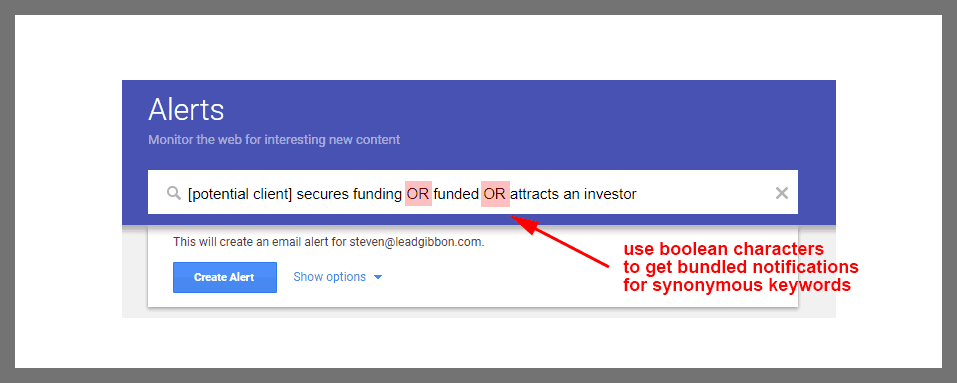
Once setting up an alert for possible opportunities becomes second nature, you’re never going to lose a lead again.
Build better relationships with your existing customers
One of the best ways of using Google Alerts is to set up an alert for your client’s company and notify them when they are mentioned somewhere.
If your client is mentioned in a positive light, be the bearer of good news and let them know that they’re on the right track. If the mention is bad, you can be the first to tell them that they should do something about it.
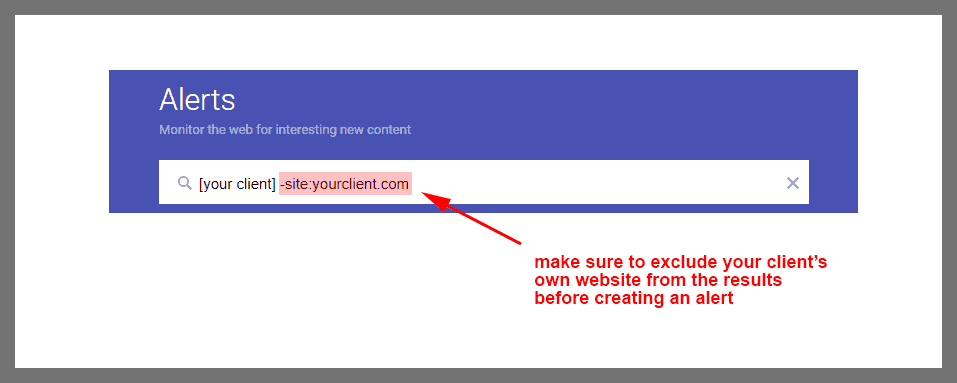
Either way, this approach translates to deeper trust and richer relationships. And sometimes even new opportunities, as your client might ask you to take care of a problem or offer you a new deal based on the information you’ve found.
Obviously, it won’t work that well if you have big clients on board who are regularly mentioned in the news. But for small startups and companies with less than 50 employees, it could mean a significant morale boost or a chance to save face — and that’s good news for you too.
Track reviews about your product to manage reputation
Of course, you don’t want to forget about your own product and how it’s doing with past customers.
Setting up keywords for basic variations of your company’s brand and product should be one of the first things you do with Google Alerts. And with some Boolean characters thrown into the mix, the results could be spot-on.
For example, let’s say that you’re a part of Slack’s sales team and you want to be notified each time a negative review comes up on the internet. Google Alerts is great for this:
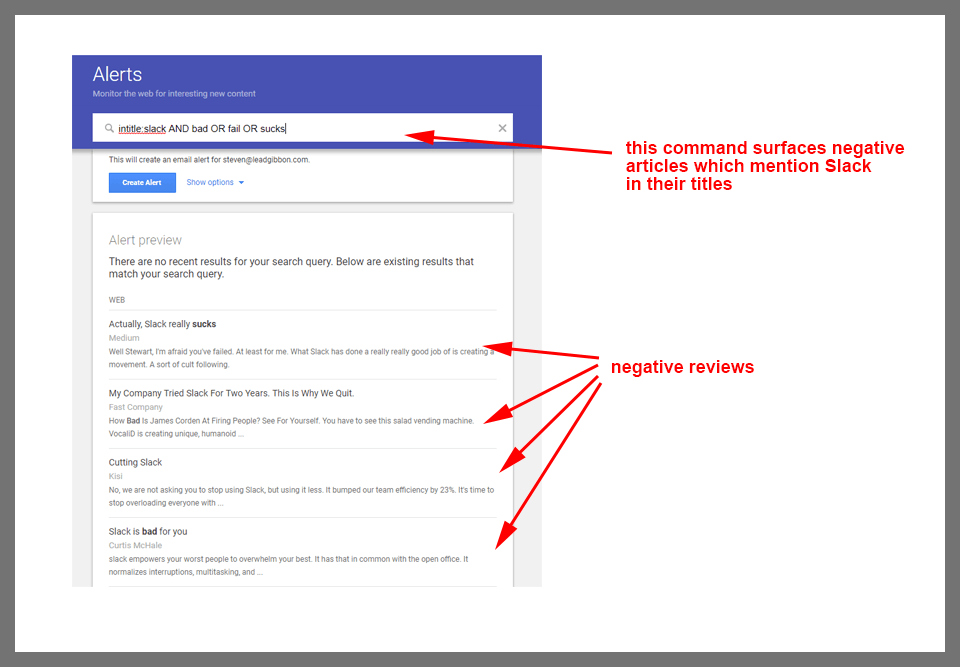
Keeping the mentions of your company in check can be helpful in a variety of ways. Here are a couple of examples of how to take advantage of it:
- If somebody posts a negative review of your product, start a dialogue and defuse the situation before it has a chance to become bigger;
- If somebody sings praise for your product, send them a quick thank you email to start a relationship and build out your network, or ask for them to participate in your case study;
- When somebody mentions your product without a link, write an email and politely ask for a backlink;
Google Alerts can even help you evaluate the bigger picture. If there are too few notifications about your brand, it might be time to rethink your marketing strategy.
Research competition
You might think that your idea is new. But chances are that you’re far from the only person on the planet with it. Which means that your business has competitors.
Google Alerts is a smart way to track what’s happening with your competition. The process is basically the same as using this tool for monitoring your own brand. Set up keywords for your competitor’s company or product and look for anything that might be useful.
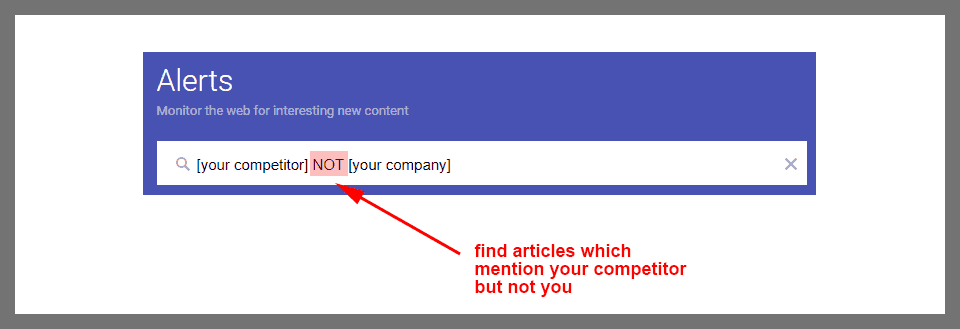
For example, if somebody mentions your competitor but not you in their article, you can quickly send an email asking the author if they had a chance to use your product. Saw that somebody’s looking for an alternative to your competitor’s product? Get on top of the situation and recommend your own.
If your competitor is much more successful than you, use them as your cheat sheet. Set up alerts to look at the tactics and strategies they use, and don’t be afraid to steal them.
So what’s the drawback?
Google Alerts just isn’t thorough enough
Google Alerts catches a lot of the relevant content — but it’s far from catching all of it.
For starters, Alerts is great for tracking news and blogs first. This means that you’ll lose on the conversations that take place on social media. But it also isn’t as accurate as dedicated third-party tools. Contify estimates that Google Alerts can ignore as much as 40% of the relevant content, which means lost opportunities.

And it wasn’t developed for sales
Google Alerts is neat. But if you want to make this kind of brand/keyword monitoring an integral part of your sales strategy, you’ll have to think about using dedicated solutions.
If you want to keep track of a certain company for example (to see if its funded) both Crunchbase and Owler offer far more in-depth results. Clearbit tracks when your lead changes jobs or positions. You can also take a look at Winmo, which allows setting up custom alerts for new hires or agency changes.
Don’t forget about LinkedIn Sales Navigator, where you can save searches based on your ideal buyer criteria and be notified via email each time someone new matches it (which is far from the only way Sales Navigator can maximize your sales – read our post on this).
Though these tools are great for sales enablement and intelligence they are far from being free. Google Alerts costs nothing, and honestly, that’s reason enough to set it up.
Conclusions
Configuring Alerts takes just a couple of minutes. So even if Google Alerts will find just a couple of opportunities for you in a year, it’s a pretty good return on investment.
So what’s our suggestion? If you want to integrate brand monitoring in your sales workflow, start with Google Alerts. After a month or two you’ll get a pretty good idea if you want to take it further and buy a dedicated solution, or maybe Google Alerts is enough to meet your needs (especially on a tight budget).
Have a tip on using Google Alerts? Share it in the comments section below!

Leave a Reply